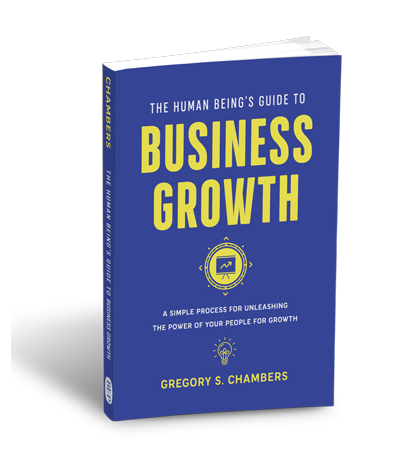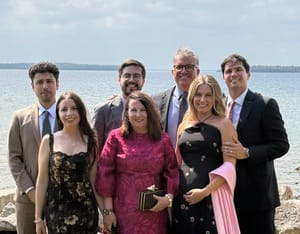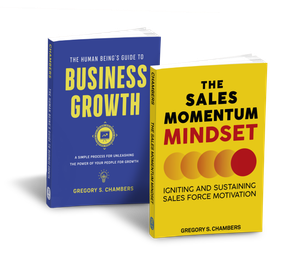Strategy in Hours
The following is taken from Chapter 3: The Vision – Strategy and Planning are Not the Same Thing, in my book, "The Human Being's Guide to Business Growth."
It’s time for your first strategic vision exercise. The days of 5-year and 10-year plans are gone. Time and distance, regardless of your industry, is compressing and each step you take into the future changes that future. To work in this new reality, you need a process for setting a strategic vision that doesn’t take a retreat, multiple days offsite, or thick binders of materials to be produced. You need a process that lets your leadership team—your small, agile leadership team—quickly set a strategic vision that your planning committee can work with. Let me show you how we do it.
Step one: Start your strategy sessions by framing this concept
Your strategic vision is firmly entrenched in the future and is divorced from the past. What I mean is the future is where we want to go without the constraints of today. It’s aspirational. The reason for that is because aspirational visions are emotional and it is emotions that drive action. It’s emotions that shake the trees and move the mountains. Logic won’t do that. Logic is what we use to justify decisions, but emotion is what drives action.

Think about your last beach vacation. The idea of sunshine, umbrella drinks, and having nothing to do for a week is an emotional idea. The idea of sunburns, overpriced buffets, and being stuck in an 11 p.m. layover at Chicago O’Hare on the way back is an emotional idea. One drives action to go, the other may drive action to skip the trip. Either way, once that decision is made, logic kicks in. If you go, logic says you got a great deal, you’re recharged and getting more done, and your team became more independent without you there. If you stay and catch up with work instead, logic says that you saved a bundle and you were there for the team when that emergency happened, because, let’s face it, there is always an emergency.
Strategic vision is three parts emotion to one part logic. Planning, on the other hand, is three parts logic with a splash of emotion. To get the recipe for your strategic vision right, ignore your present constraints in your strategy meeting today, because you are going to focus on the future.
Step two: Make the future your own
The future will look a lot more like today than we think. The exercise for step two is to make the future your own by putting your small team into the right state of mind. To do that we are going to use an exercise that the futurists like to call, remembering the future. To get there, we need three pieces: A place, a client, and an event.
Get to the flip chart, put your names across the top, and down the side, list place, client, and event. To start, go around the room and pick a place that you know well. It can be a vacation spot, your kid’s college town, or your hometown. The only requirement is that you know it well. List each attendee’s place under their name.
The client line is a company that you know well enough to name your key contacts, their main business drivers, and a little about their customers. Like “place,” the requirement is that you know the client well.
The last element of the exercise is to figure out why each of you are with your clients in that place at the same time. What is the event bringing you together? Everyone needs to take seven minutes to come up with their story. For instance, if I come up with Manzanillo, Mexico as a favorite place, and my pharmaceutical consultancy as a client I know well, why would we both be in Manzanillo at the same time? Let me take a minute and make something up.
One of the only reasons I can think of us being down there is to enter- tain a large client with a deep-sea fishing excursion and client planning session. It’s not out of the realm of possibility, and I can almost feel the sun on my face as the boat jumps the waves out to our spot. Past the big rocks protecting the bay and out in the open waters where the trophy fish are waiting.
Did it ever happen? No. But since I know Dan well, and I know the spot well, it’s easy to imagine a reason for being there and it almost feels like it’s happened. As a matter of fact, I imagine the movie The Fugitive with Harrison Ford. Dan and I are entertaining Devlin McGregor, the giant pharma company, and getting our picture taken with a monster fish.
That’s how we center the leadership team to imagine the future. Next is the meat of the exercise, imagining our industry three to five years out. What are the changes shaping our industry? What are the new challenges our customers will be facing? What will the regulatory environment be like? What technology is going to re-arrange how we operate?
That leads to answering the smaller questions our people will ask.
- What is our company’s purpose in that future?
- In that future, we’ll know we’re successful when what happens?
- What do our company values force us to act like in this future?
What you end up with is a future that your leadership team can fit answers into. Most leadership teams light up at this because it feels like progress, and it is. This is how we see the future and this is how we’ll fit in. This is where our company will provide value in the future.
Step three: Gauge the distance between where you are today, and the future you just described
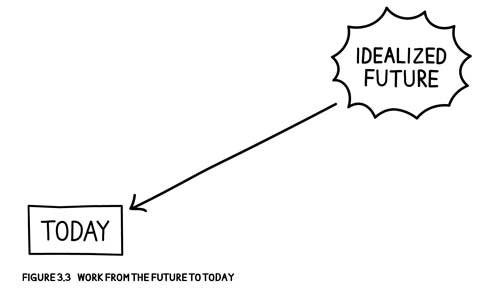
On the white board, Figure 3.3, future to today, helps describe the process thus far.
It’s here where the joy from step two dissipates. This is the right time in the strategy day to look at the limits of today’s organization. Do we have the right people? Do we have the right capital structure? Do we have the right technology?
We suggest not lingering here except to put in place some of the met- rics that you’ll be using to steer the company into that future. This is where we talk about the market size, the number of customers, the cost of operations, the number of employees, and whatever other metrics will govern the business. We don’t keep an exhaustive list because our clients have very little problem coming up with items to track. This is where you are the content expert and you make a list of possible metrics you can give to your planning committee.
Step four: Set your markers from the future to today
With a vision of the future and a list of metrics, you’re ready to jump back into the future. We start with the date we were using in step two and for this example, let’s say it’s five years into the future. Our next exercise is going to take us back into that future and we’ll start by asking this question:
What do we need in place by year four, to make year five a reality?
The question is important because the gap you’ve identified between today and the future is, and needs to be, way too large for you to get to right now. A lot of things need happen, most of them good, for your place in the future to be secured. Instead of jumping right into that future, we’re going to go almost into the future. We’re going to its doorstep and asking ourselves what the doorstep looks like.
- How many customers will we need the year before we realize our vision?
- What will the product mix look like in the year before our vision happens?
- Who will be on our team, trained and ready to lead our people into that vision?
This process is going to be repeated, as we see in the circles that come from the future back to today in Figure 3.4.
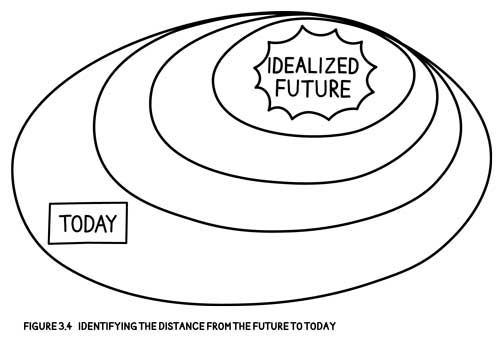
We’re going to get our small team on the same page knowing what has to happen right before year five? And what must happen right before year four? And before year three?
Before we know it, we’re into asking ourselves what needs to happen in the coming year, and that is when the strategy meeting ends, because what is going to happen next is planning, and that requires the buy-in from your next group. You should have a rough outline that looks like this in Figure 3.5.
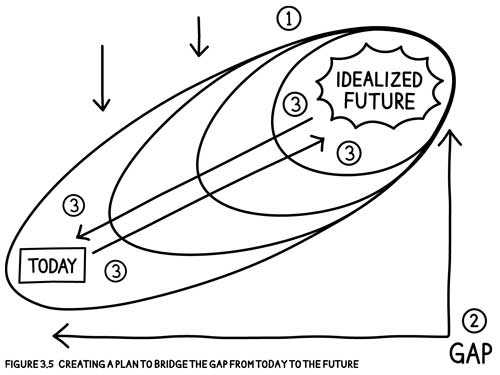
This process takes less than a day to implement and only requires quarterly maintenance to be effective. Each quarter, the leadership team gathers to answer this question: What, if anything, have we learned in the last quarter that will change our vision of the future and how we fit in?
If we’ve done our job, your leadership team should describe the exact same future to anyone who asks. It’s my test. I should be able to stop you in the hall, at any moment, and no matter who I ask, the description of the future will be the same.
For more on this subject, read my book, "The Human Being's Guide to Business Growth" from BEP. It's good stuff.


